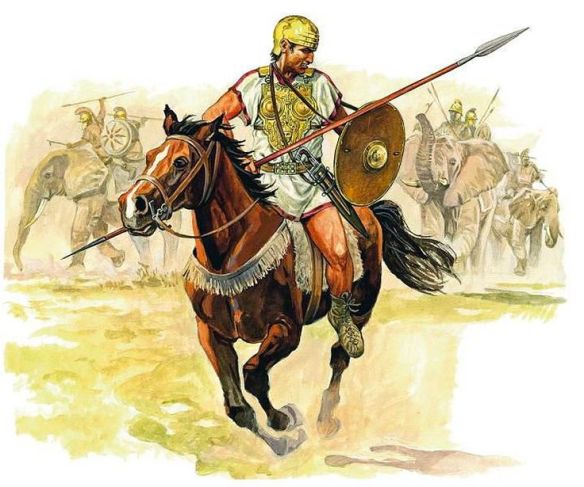Iberian [Hispanic] cavalryman, 2nd C. BC. Iberian cavalry were certainly trained and equipped to fight en masse (Polybios 3.65.6) The ancient writer Strabo described Hispanics wearing helmets with three crests, and there are also references to iron helmet-masks rather in the manner of those worn by the Romans for their cavalry sports; but for the moment we have no archaeological evidence.
From the second century on, an army sometimes included small bodies of specialist support troops too, like Balearic slingers whose accurate hurling of stones and lead bullets was legendary, or Gallic and Iberian cavalry – more maneuverable (and expendable) than citizen or Italian horse. Polybius (6.19-42) vividly depicts how the early to mid-second-century army functioned: the procedures for recruitment, the armament, the efficiently laid-out and maintained marching camp, the fearsome discipline. Much of his account is illustrated by further evidence, including archaeological: second-century Roman siege-camps near Numantia in Spain, like the famous site at Renieblas, obey Polybian principles so far as the terrain permits. Finds there and elsewhere support his description, too (6.23-24), of the legionary pila, heavy oblong shield (scutum), gladius, and armor (breastplate or, for wealthier soldiers, chain-mail coat).
The Iberians harboured a great deal of respect for horses, even worshipping them as divine creatures. In times of war the horse had previously played a minor role, but gradually progressed from a symbol of prestige and noble warrior’s ride to the battlefield, to becoming a major presence in the battle itself. Blessed with horses of great quality, Iberian cavalry grew to become one of the most potent weapons in the ancient world. Their horses were as fast and as nimble as the renowned Numidian steeds and, having been trained to cope with the rough terrain of the Peninsula, were hardy beasts also. The combination of fine mounts and dextrous riders enabled Iberian cavalry to earn a reputation that established them as mercenaries, sought after by both Carthage and Rome.
Hannibal’s Iberian cavalry
The Carthaginian army seems to have been remarkably effective under the Barcids. The core of the army which Hannibal brought to Italy was made up of subject and allied levies of Libyan and Iberian infantry and Numidian and Iberian cavalry. These troops seem to have had a strong personal tie to Hannibal, having picked him as their commander following the death of Hasdrubal. This would have given the army a very high degree of esprit de corps, and a sense of having a common purpose, which would doubtless have spread to the various mercenary contingents in the army, as well as the new Celtic and Ligurian allies who joined the army when it arrived in Italy. Such a sense of purpose could well have assumed a greater importance than the individual motives of the respective national groups.
